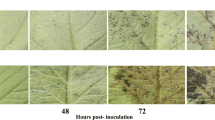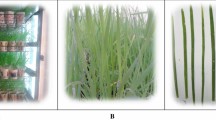Abstract
Leaves of powdery mildew-susceptible barley (Hordeum vulgare cv. Ingrid) and related near-isogenic lines bearing various resistance genes (Mla12, Mlg or mlo5) were inoculated with Blumeria graminis f. sp. hordei race A6. Fungal attack induced several-fold increases in ethylene emission and electrolyte leakage in leaves of susceptible Ingrid beginning 3 days after inoculation. Activities of peroxidase, superoxide dismutase, glutathione S-transferase, ascorbate peroxidase and glutathione reductase enzymes were induced markedly in susceptible leaves 5–7 days after inoculation. Similar, but less pronounced pathogen-induced changes were detected in inoculated leaves of Mla-type resistant plants that show hypersensitive cell death upon inoculation, and, to an even lesser extent, in the Mlg and mlo lines, where no visible symptoms accompanied the incompatible interaction. Glutathione content increased only in susceptible barley 7 days after inoculation. Catalase activity, total ascorbate content and redox state were not influenced by inoculation in any of the genotypes. The activity of dehydroascorbate reductase was significantly reduced 3–5 days after inoculation in the susceptible parental plants and after 5 days in Mla and Mlg lines, while it was stable in the mlo barley. Slightly elevated levels of H2O2 were observed in the inoculated resistant plants. In contrast, H2O2 content decreased in the susceptible line 7 days after pathogen attack. These data indicate that high levels of antioxidants are involved in the compatible interaction of susceptible barley and powdery mildew by protecting the pathogen from oxidative damage.







Similar content being viewed by others
Abbreviations
- APX:
-
ascorbate peroxidase
- Bgh :
-
Blumeria graminis f. sp. hordei
- CDNB dai:
-
1-chloro-2,4-dinitrobenzene, day(s) after inoculation
- DCF:
-
2′,7′-dichlorofluorescein
- DCFH-DA:
-
2′,7′-dichlorofluorescin diacetate
- DHA:
-
dehydroascorbate
- DHAR:
-
dehydroascorbate reductase
- GR:
-
glutathione reductase
- GST:
-
glutathione S-transferase
- hai:
-
hour(s) after inoculation
- HR:
-
hypersensitive reaction
- MDA:
-
monodehydroascorbate
- POX:
-
guaiacol peroxidase
- ROS:
-
reactive oxygen species
- SOD:
-
superoxide dismutase
References
Aebi, H. (1984). Catalase in vitro. Methods in Enzymology, 105, 121–126.
Ádám, A. L., Galal, A. A., Manninger, K., & Barna, B. (2000). Inhibition of the development of leaf rust (Puccinia recondita) by treatment of wheat with allopurinol and production of a hypersensitive-like reaction in a compatible host. Plant Pathology, 49, 317–323.
Bradley, D. J., Kjellbom, P., & Lamb, C. J. (1992). Elicitor- and wound-induced oxidative cross-linking of a proline-rich plant cell wall protein: A novel rapid defense response. Cell, 70, 21–30.
Burhenne, K., & Gregersen, P. L. (2000). Up-regulation of the ascorbate-dependent antioxidative system in barley leaves during powdery mildew infection. Molecular Plant Pathology, 1, 303–314.
El-Zahaby, H. M., Gullner, G., & Király, Z. (1995). Effects of powdery mildew infection of barley on the ascorbate-glutathione cycle and other antioxidants in different host-pathogen interactions. Phytopathology, 85, 1225–1230.
Fauth, R., & Hoffmann, G. M. (1992). Determination of quantitative resistance of wheat genotypes against Erysiphe graminis f. sp. tritici by analysis of the amount of postinfectionally produced ethylene. Journal of Plant Diseases and Protection, 99, 39–55.
Felle, H. H., Herrmann, A., Hanstein, S., Hückelhoven, R., & Kogel, K.-H. (2004). Apoplastic pH signaling in barley leaves attacked by the powdery mildew fungus Blumeria graminis f. sp. hordei. Molecular Plant-Microbe Interactions, 17, 118–123.
Foyer, C. H., Rowell, J., & Walker, D. (1983). Measurements of the ascorbate content of spinach leaf protoplasts and chloroplasts during illumination. Planta, 157, 239–244.
Hafez, Y. M., Kir, , & ly, Z. (2003). Role of hydrogen peroxide in symptom expression of barley susceptible and resistant to powdery mildew. Acta Phytopathologica et Entomologica Hungarica, 38, 227–236.
Heiser, I., Osswald, W. F., & Elstner, E. F. (1998). Photodynamic ethane and ethylene formation from α-linolenic acid catalyzed by cytokinins and copper ions. Journal of Plant Physiology, 152, 230–234.
Heitefuss, R. (2001). Defence reactions of plants to fungal pathogens: Principles and perspectives, using powdery mildew as an example. Naturwissenschaften, 88, 273–283.
Hückelhoven, R., & Kogel, K.-H. (1998). Tissue-specific superoxide generation at interaction sites in resistant and susceptible near-isogenic barley lines attacked by the powdery mildew fungus (Erysiphe graminis f. sp. hordei). Molecular Plant-Microbe Interactions, 11, 292–300.
Hückelhoven, R., Fodor, J., Preis, C., & Kogel, K.-H. (1999). Hypersensitive cell death and papilla formation in barley attacked by the powdery mildew fungus are associated with hydrogen peroxide but not with salicylic acid accumulation. Plant Physiology, 119, 1251–1260.
Jameson, P. E. (2000). Cytokinins and auxins in plant-pathogen interactions – An overview. Plant Growth Regulators, 32, 369–380.
Kerby, K., & Somerville, S. (1989). Enhancement of specific intercellular peroxidases following inoculation of barley with Erysiphe graminis f. sp. hordei. Physiological and Molecular Plant Pathology, 35, 323–337.
Király, Z., & El-Zahaby, H. M. (2000). Effect of reactive oxygen species on rust and powdery mildew pathogens and on symptoms. Acta Phytopathologica et Entomologica Hungarica, 35, 239–240.
Klapheck, S., Zimmer, I., & Cosse, H. (1990). Scavenging of hydrogen peroxide in the endosperm of Ricinus communis by ascorbate peroxidase. Plant Cell Physiology, 31, 1005–1013.
Kølster, P., Munk, L., Stølen, O., & Løhde, J. (1986). Near-isogenic barley lines with genes for resistance to powdery mildew. Crop Science, 26, 903–907.
Kristensen, B. K., Bloch, H., & Rasmussen, S. K. (1999). Barley coleoptile peroxidases. Purification, molecular cloning, and induction by pathogens. Plant Physiology, 120, 501–512.
Law, M. Y., Charles, S. A., & Halliwell, B. (1983). Glutathione and ascorbic acid in spinach (Spinacia oleracea) chloroplasts. The effect of hydrogen peroxide and of paraquat. Biochemical Journal, 210, 899–903.
Levine, A., Tenhaken, R., Dixon, R. A., & Lamb, C. (1994). H2O2 from the oxidative burst orchestrates the plant hypersensitive disease resistance response. Cell, 79, 583–593.
Lu, H., & Higgins, V. J. (1998). Measurement of active oxygen species generated in planta in response to elicitor AVR9 of Cladosporium fulvum. Physiological and Molecular Plant Pathology, 52, 35–51.
Mauch, F., & Dudler, R. (1993). Differential induction of distinct glutathione-S-transferases of wheat by xenobiotics and by pathogen attack. Plant Physiology, 102, 1193–1201.
Nakano, Y., & Asada, K. (1981). Hydrogen peroxide is scavenged by ascorbate-specific peroxidase in spinach chloroplasts. Plant Cell Physiology, 22, 867–880.
Noctor, H., & Foyer, C. H. (1998). Ascorbate and glutathione: Keeping active oxygen under control. Annual Review of Plant Physiology and Plant Molecular Biology, 49, 249–279.
Olson, P. D., & Varner, J. E. (1993). Hydrogen peroxide and lignification. Plant Journal, 4, 887–892.
Ouf, M. F., Gazar, A. A., Shehata, Z. A., Abdou, E. S., Király, Z., & Barna, B. (1993). The effect of superoxide anion on germination and infectivity of wheat-stem rust (Puccinia graminis Pers f. sp. tritici Eriks and Henn) uredospores. Cereal Research Communications, 21, 31–37.
Paoletti, F., & Mocali, A. (1990). Determination of superoxide dismutase activity by purely chemical system based on NAD(P)H oxidation. Methods in Enzymology, 186, 209–220.
Piffanelli, P., Zhou, F. S., Casais, C., Orme, J., Jarosch, B., Schaffrath, U., et al. (2002). The barley MLO modulator of defense and cell death is responsive to biotic and abiotic stress stimuli. Plant Physiology, 129, 1076–1085.
Rathmell, W. G., & Sequeira, L. (1974). Soluble peroxidase in fluid from the intercellular spaces of tobacco leaves. Plant Physiology, 53, 317–318.
Renard-Merlier, D., Randoux, B., Nowak, E., Farcy, F., Durand, R., & Reignault, P. (2007). Iodus 40, salicylic acid, heptanoyl salicylic acid and trehalose exhibit different efficacies and defence targets during a wheat/powdery mildew interaction. Phytochemistry, 68, 1156–1164.
Schulze-Lefert, P., & Panstruga, R. (2003). Establishment of biotrophy by parasitic fungi and reprogramming of host cells for disease resistance. Annual Review of Phytopathology, 41, 641–667.
Thordal-Christensen, H., Zhang, Z., Wei, Y., & Collinge, D. B. (1997). Subcellular localization of H2O2 in plants. H2O2 accumulation in papillae and hypersensitive response during the barley-powdery mildew interaction. Plant Journal, 11, 1187–1194.
Vanacker, H., Carver, T. L. W., & Foyer, C. H. (1998). Pathogen-induced changes in the antioxidant status of the apoplast in barley leaves. Plant Physiology, 117, 1103–1114.
Vanacker, H., Carver, T. L. W., & Foyer, C. H. (2000). Early H2O2 accumulation in mesophyll cells leads to induction of glutathione during the hyper-sensitive response in the barley-powdery mildew interaction. Plant Physiology, 123, 1289–1300.
Wang, S. Y., & Tzeng, D. D.-S. (1998). Methionine-riboflavin mixtures with surfactants and metal ions reduce powdery mildew infection in strawberry plants. Journal of the American Society for Horticultural Science, 123, 987–991.
Zhang, Z., Henderson, C., & Gurr, S. J. (2004). Blumeria graminis secretes an extracellular catalase during infection of barley: Potential role in suppression of host defence. Molecular Plant Pathology, 5, 537–547.
Acknowledgements
This research was supported by the Hungarian Scientific Fund (OTKA T042801, T046548, T048572, K61594) and German–Hungarian Bilateral Research Fund D-7/04.
Author information
Authors and Affiliations
Corresponding author
Rights and permissions
About this article
Cite this article
Harrach, B.D., Fodor, J., Pogány, M. et al. Antioxidant, ethylene and membrane leakage responses to powdery mildew infection of near-isogenic barley lines with various types of resistance. Eur J Plant Pathol 121, 21–33 (2008). https://doi.org/10.1007/s10658-007-9236-3
Received:
Accepted:
Published:
Issue Date:
DOI: https://doi.org/10.1007/s10658-007-9236-3




